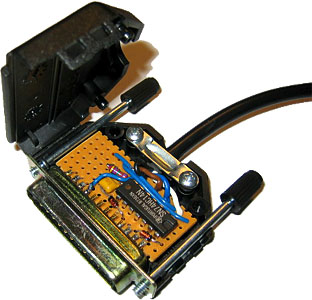
 |
||||||
| HARDWARE | DOWNLOADS | MISCELLANEOUS | ||||
 |  |
||||
 |
FLASHING | ||||
CAUTION: Trying to modify the built-in firmware of a mobile phone may render it practically unrepairable. This applies especially to phones that do not have a separate EEPROM chip for settings and calibrations (e.g. most Nokia 3xxx phones). Before trying to update the flash memory, you need to understand the functions of your flashing program and the whole flashing process, including any checksum updates required. NuukiaWorld does not give any support in flashing-related questions.

NuukiaWorld have not analyzed the actual operation of the Dejan's
flashing
cable. The basic idea is to keep the phone MBUS and FBUS pins in a
specific state when powering up the phone, and then transfer the data
between the PC and phone synchronously using MBUS pin for clock signal.
This cannot be done using PC serial (COM) port, so we need to use the
parallel (LPT) port, which allows generating the required waveforms.
Dejan's design seem to work, so there is nothing to modify. In my version of the schematics, the inverters in 74HC14 are rearranged for efficient layout on simple copper-striped board. Also the unused gates are tied to valid signals.
The diodes, capacitor and resistor generates power for the IC. The
IC
converts the 5-volt signals of the PC to close the 2.8-volt system of
the phone, and that is why the IC is not powered directly
from PC's 5-volt power supply. (And actually, PC does not provide
its 5
V supply on the parallel port.)
| Count |
Component |
Notes |
|---|---|---|
| 1 |
74HC14 (DIL case) |
there is no space for an IC socket |
| 2 |
1N4148 |
|
| 1 |
4,7 kΩ |
|
| 1 |
100 Ω |
required only if Vpp is used |
| 1 |
100 nF |
multi-layer ceramic capacitor is small enough |
| 1 |
D25 male connector |
|
| 1 |
D25 connector case |
plastic with enough free space |
| copper-striped board |
see the layout picture below |
|
| cable (4...6 wires) |
for connection to the phone connector |
|
| 1 |
phone connector |
not sold on regular stores, you need to improvise |

Because the circuit is rather simple, I did not make a real PCB for it. Instead of it, I used simple copper-striped veroboard. It is possible to fit the circuit directly in D25 connector case so no separate box is required.
The board is pushed between the D25 connector soldering pins so that
pins 1...13 (numbered on the connector) are on the copper-striped side
of the board. Because connector pin-spacing does not match the
2.54 mm raster of the board, you need to position the connector so that
each of pins 1...6 and 11...13 touch one copper stripe without
possibility of short circuits. You need to remove the copper at pins
7...10 (black area in the layout picture) to avoid short-circuits.
Note that the layout picture on the right is viewed from the
component side. So the pins 1...13 of the D25 connector shown in the
picture are actually on the opposite side of the board and pins 14...25
(omitted from the picture) are visible on the component side (the
copper-free side).

 The diodes must be soldered so that they do not make any
short-circuits. I have wired them onto the component side directly
through the first available holes (see photos). The copper must be
naturally removed around those holes. Only one pin is used on the other
row of the connector; pin 22 is connected with a wire to the circuit
(see picture).
The diodes must be soldered so that they do not make any
short-circuits. I have wired them onto the component side directly
through the first available holes (see photos). The copper must be
naturally removed around those holes. Only one pin is used on the other
row of the connector; pin 22 is connected with a wire to the circuit
(see picture).
Finally you need to find a connector for your phone, and use a
suitable cable to connect the required signals from the board to
connector. You will need to connect at least signals MBUS, FBUS
Tx,
FBUS Rx, and GND. For Nokia 3210 you need to connect
also Vpp (as far as I know). On 3210,
connection to Btemp is optional but if it is connected you
probably do not
need to press the power button manually to start the flashing
operation. — If you do not need Vpp or Btemp signals,
you may leave the 100 Ω resistor and corresponding wires unassembled.
For pin-outs of some DCT-3 phones, visit NuukiaWorld's old FBUS/MBUS cable pages.
3.1.2006  nuukiaworld@gmail.com
nuukiaworld@gmail.com
No email support or answers to technical questions.